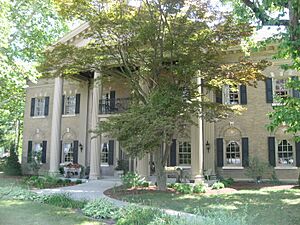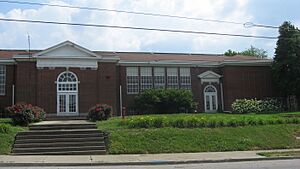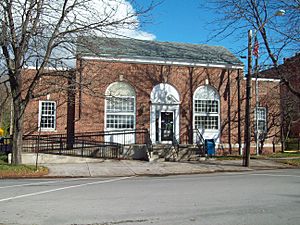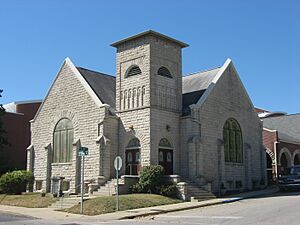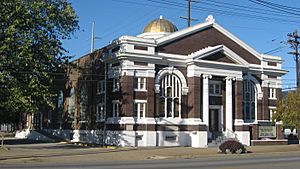Samuel Plato facts for kids
Quick facts for kids
Samuel M. Plato
|
|
|---|---|
| Born | 1882 |
| Died | May 1957 |
| Nationality | American |
| Occupation | Architect |
| Buildings | J. Woodrow Wilson House (Marion, Indiana); Broadway Temple A.M.E. Zion Church (Louisville, Kentucky); Virginia Avenue Colored School, (Louisville) |
Samuel M. Plato (1882–1957) was an amazing American architect and builder. He was famous for his work on big government housing projects and post offices. He also designed and built many other buildings across the United States. These included homes, banks, churches, and schools.
During World War II, Samuel Plato was one of the few African-American builders to get important wartime contracts. These jobs included building dorms for over 800 African-American defense workers in Washington, D.C.. He also built at least 38 U.S. post offices! Plato started his career in 1902 in Marion, Indiana. This was a time when it was very hard for African-American professionals because of segregation and racism. In 1921, he moved to Louisville, Kentucky, where he lived for the rest of his life. Some of his most important buildings are now listed on the National Register of Historic Places. This means they are special and important to history.
Contents
Becoming an Architect and Builder
Samuel M. Plato was born in 1882 in Waugh, Alabama. His parents were James and Katie Plato. His father, James, was a farmer who taught Samuel about carpentry and other building skills.
Plato finished school at the Mount Meigs Colored Institute in Alabama. He then studied for another year in Winston-Salem, North Carolina. In 1898, he went to State University Normal School in Louisville, Kentucky. This school is now called Simmons College of Kentucky. While in college, he worked on construction sites during his summer breaks. He graduated in 1902. He also took a special mail-order course in architecture. This course was from the International Correspondence Schools in Scranton, Pennsylvania.
Samuel Plato's Building Career
Plato started working as a builder in the early 1900s. Back then, discrimination often meant that African Americans could only get jobs as unskilled workers. But Samuel Plato wanted more. He chose to become an architect and builder. These jobs offered better pay and more chances to grow. Plato was a pioneer, one of the first African-American architects in the Midwest.
Around 1902, after college, he moved to Marion, Indiana. He worked there for 19 years as an architect and builder. Then, around 1921, he moved back to Louisville, Kentucky. Besides projects in Indiana and Kentucky, Plato designed and built buildings all over the United States.
Building in Indiana
During his time in Indiana, Samuel Plato found support from rich business owners like John Schaumleffel and J. Woodrow Wilson. This was helpful because the Ku Klux Klan was very strong in Indiana at that time. Plato also worked with Jasper Burden, another black builder in Marion, for about ten years.
Plato's early projects in Marion included the Second Baptist Church, finished in 1905. He also built the beautiful Classical Revival-style First Baptist Church in 1913. The Platonian Apartments were built in 1910.
One of Plato's most famous homes was the J. Woodrow Wilson House in Marion. He designed and built this 15-room house in 1912. This Neoclassical-style home was one of the "finest structures in the city." It was added to the National Register of Historic Places in 1988.
Plato also built other homes and businesses in Indiana. Examples include the First United Baptist Church in Wabash. He also built the Second Baptist Church in Bloomington, Indiana. This church was added to the National Register of Historic Places in 1983. Another project was the Swallow-Robin residence hall. This building was built in 1917 at Taylor University in Upland, Indiana.
While working in Marion, Plato was known for hiring both black and white workers. This was very rare back then. His practice of hiring African-American workers, especially for skilled jobs, helped them improve their abilities. His efforts also helped open up building trade unions to African-American workers.
Building in Kentucky
Plato moved back to Louisville, Kentucky, around 1920 or 1921. There, he continued his work as an architect and builder. His big projects in Louisville include the Broadway Temple A.M.E. Zion Church. This church was added to the National Register of Historic Places in 1980. He also built the James Lee Memorial Presbyterian Church.
Plato also designed the Virginia Avenue Colored School. This school was added to the National Register of Historic Places in 2004. He also worked on Steward Hall at Simmons College of Kentucky. This building is also on the National Register of Historic Places. Plato even designed two banks in Louisville. A neighborhood he helped build was named Plato Terrace in his honor. Around 1945, he helped create the Westover neighborhood with small, two-bedroom houses.
Working for the U.S. Government
Plato is most famous for his work on government housing projects. He was reportedly the first African-American to get a contract to build a U.S. post office. He received contracts, mostly in the 1930s, to build at least 38 U.S. post offices. These were in towns like Coldwater, Ohio; Goshen, New York; Fredonia, New York; and Decatur, Alabama.
During World War II, Plato's government housing projects for defense workers made him famous across the country. Between 1941 and 1946, he was one of the few African-American architects and builders to get wartime contracts. Even though President Franklin D. Roosevelt made a rule against discrimination in defense jobs, it was still hard for black businesses to get these contracts. Plato's projects included Wake and Midway Halls. These were dorms for over 800 African-American defense workers in Washington, D.C. Another big project was Sparrows Point, a large housing complex in Baltimore, Maryland.
Helping the Community
Besides his building career, Samuel Plato was active in many community groups. These included the Young Women's Christian Association and the National Urban League. He was also a member of the Phi Beta Sigma fraternity. In 1927, he was the vice president of the National Negro Builders Association. Plato was also a popular speaker at places like Tuskegee Institute and Howard University.
Family Life
Samuel Plato's first wife, Nettie Plato, is buried in Marion, Indiana. His second wife was Elnora Davis Lucas Plato. She had her own successful dressmaking business. She helped her husband with his business and traveled with him often. Around 1929, Samuel built a beautiful Tudor Revival-style home for himself and Elnora in Louisville, Kentucky.
Plato believed in helping others and his family. He and Elnora helped several nieces and nephews go to college. He also hired some of them for jobs in Louisville and Washington, D.C.
Samuel Plato's Legacy
Samuel Plato passed away in May 1957 in Louisville, Kentucky. He was known across the country as a pioneer, an important African-American architect and builder. He started his career when it was very difficult for black professionals because of racism. People admired and respected Plato. He once said, "My whole goal in life has been to improve and help others who come up behind me."
Historians say Plato's success came from his hard work and his reputation for quality. His work was featured in newspapers and magazines like Ebony. After visiting two of his wartime housing projects, First Lady Eleanor Roosevelt even wrote about them in her newspaper column in 1943.
Plato designed and built many different kinds of buildings. These included homes, banks, churches, schools, and government housing projects. He is believed to be the first African American to design a U.S. post office. He built at least 38 post offices across the country! At least eight of his projects are listed on the National Register of Historic Places. These include the Broadway Temple A.M.E. Zion Church and the Virginia Avenue Colored School in Louisville, Kentucky. Also, the J. Woodrow Wilson House in Marion, Indiana, and the Second Baptist Church in Bloomington, Indiana.
Honors and Awards
- Howard University's School of Engineering and Architecture honored Plato after he passed away in 1960. He had been a special lecturer there.
- The Indiana Historical Bureau placed a special historical marker in Plato's honor on July 25, 2015. It is in front of the J. Woodrow Wilson House in Marion, Indiana.
- A Kentucky state historical marker for Plato was put up in front of Broadway Temple A.M.E. Zion Church in Louisville, Kentucky, in February 2019.
Selected Buildings by Samuel Plato
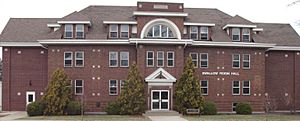
In Indiana
- First Baptist Church, Marion
- First United Baptist Church, Wabash
- J. Woodrow Wilson House (NRHP), Marion
- Platonian Apartments, Marion
- Second Baptist Church (NRHP), Bloomington
- Swallow-Robin residence hall at Taylor University, Upland
In Kentucky
- Broadway Temple A.M.E. Zion Church (NRHP), Louisville
- Green Street Baptist Church, Louisville
- James Lee Presbyterian Church, Louisville
- Virginia Avenue School (NRHP), Louisville
- Steward Hall at Simmons College of Kentucky, Louisville
In New York
- U.S. Post Office, Fredonia
In Ohio
- Pythian Temple, now the Martin Luther King Performing and Cultural Arts Complex, Columbus


